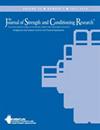县际卡莫吉比赛期间的体能和生理需求。
摘要
摘要:Duggan,JD,Byrne,P,Malone,S,Cooper,S-M,and Moody,J.the physical and physiological demands of intercounty camogie during competitive match-play.J Strength Cond Res 38(9): e510-e520, 2024-这项研究的目的是确定不同位置和半场比赛的郡际卡莫吉球比赛对身体和生理的要求。研究使用全球定位系统(10 赫兹)和心率监测器(2.4 赫兹)收集了 28 名球员在 18 场竞技比赛中的数据。研究表明,县际卡莫吉球员的总距离(TD)(米±标准差)为 6,040 ± 628 米,相对距离(RD)为 83 ± 13 米-分钟-1,最大速度为 25 ± 1 公里-小时-1。此外,运动员的平均冲刺距离为 214 ± 112 米,冲刺次数为 14 ± 6 次。球员的平均心率(HRmean)和最大心率(HRmax)分别为 138 ± 23 b-min-1 和 164 ± 20 b-min-1。半场之间,TD(p < 0.01,ES = -0.45)、RD(p < 0.01,ES = -0.45)、最大速度(p < 0.05,ES = -0.18)、最大心率(p < 0.05,ES = -0.23)、跑步(p < 0.05,ES = -0.18)、最大心率(p < 0.01,ES = -0.45)、最大速度(p < 0.05,ES = -0.18)、最大心率(p < 0.05,ES = -0.45)均有所下降。23)、跑步(p < 0.01,ES = -0.34)、高速跑(p < 0.01,ES = 0.34)、短跑(p < 0.01,ES = -0.10)、最大心率(p < 0.05,ES = -0.23)和最大心率百分比(p < 0.05,ES = -0.24)。与全前锋(p < 0.05,ES = -0.38)和半前锋(p < 0.05,ES = -0.38)相比,中场球员的TD覆盖范围更大。与中场球员(p < 0.05,ES = -1.2)、半后卫与全前锋(p < 0.05,ES = 1.14)以及半前锋与全前锋(p < 0.05,ES = 1.15)相比,全后卫的区域覆盖率明显较低。与中后卫(p < 0.05,ES =-1.14)、中场球员(p < 0.05,ES =-1.47)和半前锋(p < 0.05,ES =-1.15)相比,全前锋的覆盖区域明显较少。这些研究结果提供了县际卡莫吉比赛对身体和生理要求的数值。Abstract: Duggan, JD, Byrne, P, Malone, S, Cooper, S-M, and Moody, J. The physical and physiological demands of intercounty camogie during competitive match-play. J Strength Cond Res 38(9): e510-e520, 2024-The aim of this study was to determine the physical and physiological demands of intercounty camogie match-play between positions and halves of play. Data were collected from 28 players during 18 competitive games using global positioning systems (10-Hz) and heart rate monitors (2.4-GHz). The study demonstrated that intercounty camogie players covered a total distance (TD) (m ± SD) of 6,040 ± 628 m, relative distance (RD) of 83 ± 13 m·min-1, and maximum speed of 25 ± 1 km·h-1. Furthermore, the players covered a mean sprint distance of 214 ± 112 m and 14 ± 6 sprints. Players' mean heart rate (HRmean) and HRmax was 138 ± 23 b·min-1 and 164 ± 20 b·min-1, respectively. There were decrements between halves in TD (p < 0.01, ES = -0.45), RD (p < 0.01, ES = -0.45), maximum speed (p < 0.05, ES = -0.18), HRmax (p < 0.05, ES = -0.23), running (p < 0.01, ES = -0.34), high-speed running (p < 0.01, ES = 0.34), sprinting (p < 0.01, ES = -0.10), HRmax (p < 0.05, ES = -0.23), and HRmax % (p < 0.05, ES = -0.24). Midfielders covered a greater TD compared with full-forwards (p < 0.05, ES = -0.38) and half-forwards (p < 0.05, ES = -0.38). Full-backs covered a significantly lower RD than midfielders (p < 0.05, ES = -1.2), half-backs compared with full-forwards (p < 0.05, ES = 1.14), and half-forwards compared with full-forwards (p < 0.05, ES = 1.15). Full-forwards covered significantly less RD when compared with half-backs (p < 0.05, ES = -1.14), midfielders (p < 0.05, ES = -1.47), and half-forwards (p < 0.05, ES = -1.15). The findings provide physical and physiological values on the match demands of intercounty camogie match-play.

 求助内容:
求助内容: 应助结果提醒方式:
应助结果提醒方式:


